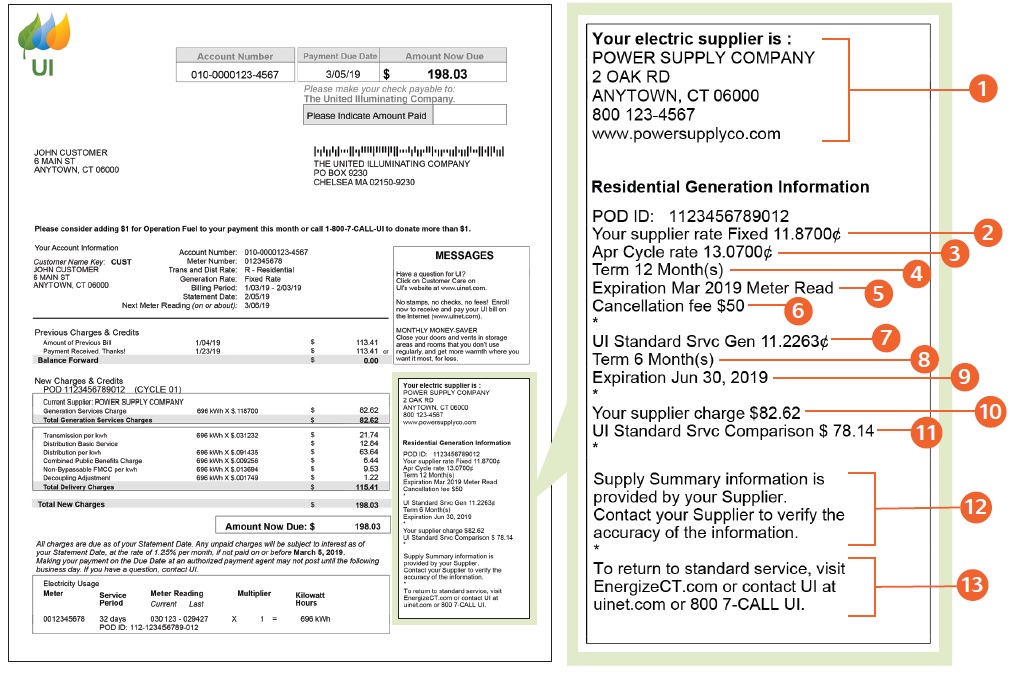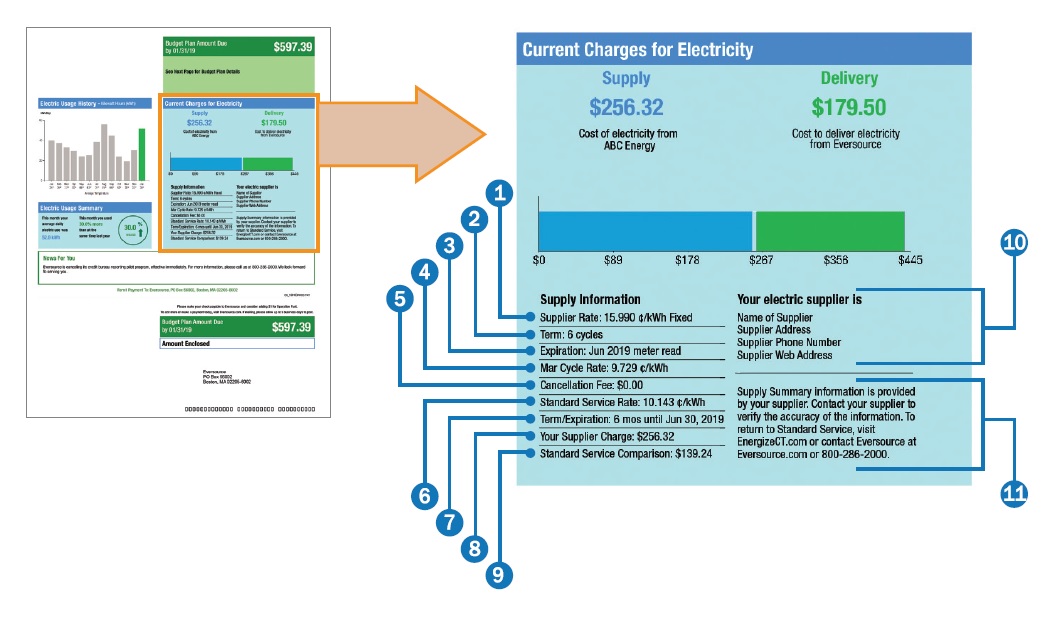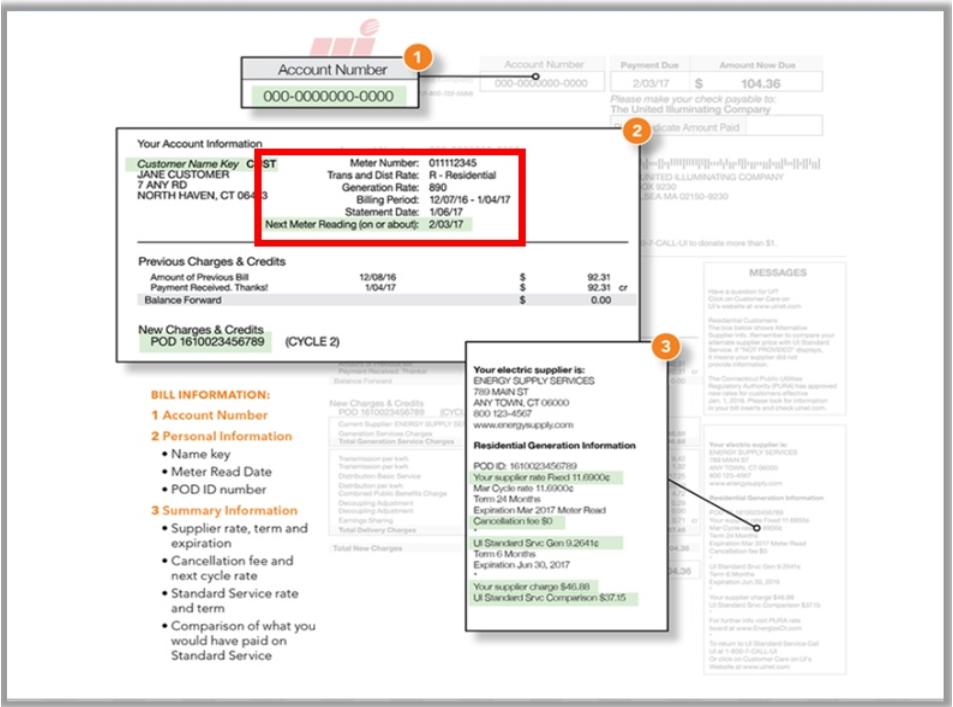Make an Informed Decision When Choosing a New Supplier ➞

Understanding the Basics
About Standard Service Rates
Standard Service is the generation supply option offered by Eversource and UI. These rates change on January 1st and July 1st and remain fixed for 6 months.
Eversource and UI do not own electric generation plants nor produce electricity. Instead, they purchase electricity in the marketplace to serve customers on Standard Service Generation. Standard Service Generation rates are based on the market price for electricity.
Standard Service rates reflect the actual cost paid by Eversource and UI to purchase electricity. As a result, Eversource and UI do not earn a profit by providing Standard Service generation supply.
The Standard Service rates are announced about 45 days prior to becoming effective and are posted on the EnergizeCT.com Rate Board page and each utility’s website when they are approved.
Customers can choose a licensed supplier for their generation services which may lower their cost, although, in some cases the Standard Service rate is the lowest rate.
About Licensed Supplier Offers
Suppliers are licensed by the Public Utilities Regulatory Authority (PURA) and offer an alternative to Eversource and UI Standard Service Generation Supply Rates.
It is important to know that regardless of the electric supplier you choose, Eversource or UI will deliver your electricity, bill you for service, and respond to power outages. Only Eversource or UI can terminate your service.
You can compare Standard Service Generation Rates to offers from Licensed Suppliers on Connecticut's Official Rate Board.
Take Your Time When Reviewing Available Offers
By shopping for competing suppliers, you may be able to save money. As you shop for electric suppliers think about what is most important to you. Read offers carefully and ask questions before enrolling.
As with any offer, you should be sure you understand and agree with the terms before signing up. Remember, remaining with the Standard Service Rate could be the best option for you.
Consider asking suppliers the following questions:
- What is the length of the contract?
- Is there a cancellation fee? (Residential contracts may not have early termination fees.)
- Are there other fees associated with the contract (such as enrollment or monthly fees)?
- What are my monthly savings if I switch?
- Will the contract automatically renew at the end of the term?
- How much notice must I give if I don't wish to renew?
- Is a security deposit, enrollment, or other similar fee required?
- Is there a credit check, late payment fee, or other similar fee assessed? (If yes, be sure to get a list of the charges and what each charge will cost.)
- Do you offer any other services? (Some examples include energy assessments, conservation services, load management, or other energy-related services.)
Important Information: Learn About Fees, Protecting Your Account and a "Do Not Switch" Block
- Protect your account information as you would your Social Security or credit card numbers. It is not necessary to provide your account information unless you are ready to enroll.
- Standard Service customers may request a do-not-switch block to prevent unauthorized switching, aka “slamming”. If you want to switch to a supplier you must call your utility company to remove the do-not-switch block from your account.
- Be aware of enrollment fees. Enrollment fees can vary and are payable upon enrollment.
FACT:
Connecticut no longer allows suppliers to enroll residential customers into contracts with cancellation fees, also know as early termination fees.
FACT:
Business customers cancellation fees still apply if applicable and cancellation fees are not capped.
FACT:
Enrollments are NOT SUBMITTED/PROCESSED on the day that you enroll with a supplier:
- When you enroll with a new supplier, the supplier must hold your enrollment for three days in case you choose to cancel. You can cancel without penalty during that time period.
- Once your new supplier submits the enrollment, Eversource and UI need two business days to process it. Weekends and holidays are not considered business days.
These safeguards are intended to protect you, the consumer.
FACT:
The ideal time to enroll with a supplier or to switch from supplier-to-supplier is TEN BUSINESS DAYS before your meter read date (see meter reading date below). This gives you three days to change your mind as well as time for your new supplier to submit the enrollment to the utility and the utility to process it.
- If you enroll too close to your next scheduled meter read date the enrollment may not be processed in time for the next month's billing. In this case, the utility will hold the enrollment and it will NOT BE PROCESSED until the following month's meter reading.
- In some cases, the supplier might not submit an enrollment immediately after the three day cancellation period or may submit the enrollment immediately after the cancellation period which could fall on a Saturday (non-business day) or later in the day on say a Friday, before a Monday holiday (Saturday, Sunday and Monday being non-business days). These and other scenarios will require more than five business days to successfully process an enrollment.
FACT:
To avoid delays in processing your enrollment, you must provide accurate information:
- Eversource customers must provide their account number, name key and service reference number.
- UI customers must provide their account number, name key and POD Identification number.
Consumers often ask "Why are electric delivery costs so high?" Take a few minutes to learn about the costs that are recovered through your electric bill.
- Video: Understand Your Eversource Electric Bill
- Video: Understand Your United Illuminating Electric Bill
When looking for ways to lower your electric cost, it is very important to understand your bill, how to manage your generation supply rates and that choosing a supplier does not affect your delivery rates.
There are two parts to your electric bill, delivery charges and generation supply charges. These are described below.
DELIVERY CHARGES
Delivery charges are fully regulated and not open to competition, delivery charges cover items such as distribution, transmission, and a public benefits charge.
PURA recently suspended a rate increase to the Eversource delivery rates that was effective July 1, 2020 and will reexamine that increase in Docket No. 20-01-01.
GENERATION SUPPLY CHARGES
Generation supply charges are deregulated and open to competition from licensed suppliers. Generation supply charges reflect the cost of the electricity you use.
If you choose a supplier to lower your electric costs PURA strongly encourages you to review your contract rate and term to avoid increases that can occur when the contract ends.
SUPPLY SUMMARY
The supply rate and other contract information are displayed on the first page of your residential electric bill. To understand the Supply Summary see: Supply summary - First page of residential electric bills below.
Contact PURA at 800-382-4586 if you need help understanding the Supply Summary.
As a UI or Eversource residential customer you are urged to regularly review important information that is displayed on the first page of your electric bill. E-Bill customers and those who have automatic payment arrangements must open the billing statement to view this critical information.
Please share this information with family and friends.
Suppliers are required to provide information about your residential generation supply contract to UI and Eversource who in-turn must display this on the first page of your electric bill.
Suppliers are responsible for the accuracy of this data and the Supply Summary must include:
- Supplier contact information
- Supplier's current generation supply rate
- Supplier's contract term and expiration
- Supplier's Next Cycle Rate: the rate that will be assessed in your next usage period
- The Eversource or UI Standard Service generation supply rate
- A comparison of the total amount charged by the supplier and what you would be charged at the Standard Service Rate
If "Not Provided" is displayed anywhere in the Supply Summary, you can contact your supplier to request the information or contact PURA.
If you have questions about electric suppliers or the Supply Summary or wish to file a complaint you can call PURA's Consumer Affairs Unit toll-free at (800) 382-4586 or contact PURA electronically.
UI Supply Summary:

- Contact Information: Your Supplier's information
- Supplier Rate: The supply rate charge per kilowatt-hour by the Supplier
- Next Cycle Rate: The Supplier rate for your next usage period
- Term: How many billing cycles the Supplier rate will be assessed
- Expiration: The meter read date the Supplier rate expires
- Cancellation Fee: Connecticut no longer allows suppliers to enroll residential customers into contracts with early termination fees
- Standard Service Rate: The current UI supply rate
- Standard Service Term: The duration of the Standard Service rate
- Expiration: The date that the Standard Service rate expires
- Your Supplier Charge: The total charge from your Supplier
- UI Standard Service Comparison: The amount you would have paid at the UI Standard Service rate
- Supply Summary: Informs you that your Supplier provides UI the information that is listed and that you should review for accuracy
- Return to Standard Service: How to return to the Standard Service rate.
Eversource Supply Summary:

- Supplier Rate: The generation rate charge per kilowatt-hour by the Supplier
- Term: How many billing cycles the Supplier rate will be assessed
- Expiration: The meter read date the Supplier rate expires
- Next Cycle Rate: The Supplier rate for your next usage period
- Cancellation Fee: Connecticut no longer allows suppliers to enroll residential customers into contracts with early termination fees
- Standard Service Rate: The current Eversource Standard Service supply rate
- Standard Service Term & Expiration: The duration of the Standard Service rate and date it ends
- Your Supplier Charge: The total charge from your Supplier
- Eversource Standard Service Comparison: The amount you would have paid at the Eversource Standard Service rate
- Contact Information: Your Supplier's information
- Message: Information about the Supply Summary and how to return to the Standard Service rate
Customers are often told that switching to a supplier can take one or two meter cycles, or up to two months. The fact is that the process is designed to switch an account on the customer's next scheduled meter reading date. If you are considering switching suppliers, PURA recommends to do so ten days prior to the next meter reading date.
Where do I find my next meter reading date?
This information can be found on your utility bill. See sample bills below.
Eversource Residential Bill - Meter Reading Information - Page 2

UI Residential Bill - Meter Reading Information - Page 1

Understanding the Process of Enrolling With a Licensed Supplier
Switching from the Eversource or UI Standard Service Rate to an electric Licensed Supplier Rate or from supplier-to-supplier is easy. (Customers may return to Standard Service simply by calling the utility and requesting to return.)
The switch from the Standard Service Rate to a Licensed Supplier Rate can only happen on your meter reading date. For this reason PURA encourages you to put in your request at least ten business days prior to your next meter read date. You can find your meter read date on your utility bill. (See "Where to find the Meter Reading Date" in the section above.)
When putting in your request, make sure you provide accurate information, otherwise your request can be delayed
PROVIDE ACCURATE ACCOUNT INFORMATION
- UI and Eversource cannot process an enrollment unless all account information is accurate.
- Providing incorrect account information will delay your enrollment.
ENROLL TEN BUSINESS DAYS BEFORE YOUR NEXT METER READ DATE
The process for switching to a supplier or from supplier-to-supplier includes these safeguards:
- Allow UI and Eversource time to check the accuracy of your account information.
- Allow for Suppliers to contact you to correct any errors in your account information.
- Provide you three business days to change your mind or cancel an enrollment.
- Provide UI and Eversource about two business days for internal processing.
- This is a total of about ten business days.
ADDITIONAL INFORMATION
- If your account is not switched on the next scheduled meter read date it cannot be switched until one month later, on your subsequent month's meter read date.
- After enrolling, you are encouraged to check with the supplier and UI or Eversource to be sure the enrollment is being processed.
- Some suppliers are not processing customer enrollments quickly or not promptly notifying customers when there are problems with an enrollment.
- Contact the Connecticut Public Utilities Regulatory Authority at 800-382-4586 if you believe your enrollment is not being promptly processed or with any questions or complaints.
- REMEMBER: You should enroll with a supplier ten business days before your next meter reading date to have your account switched on that date.
Yes. The Standard Service is the generation supply option provided by Eversource and UI and is available to all residential and small business customers.
Residential customers can return to Eversource or UI Standard Service at any time.
Preparing to switch back to Standard Generation service:
- Business customers should check with their electric Supplier about any cancelation fees. (Residential customers may not be charged a cancellation fee.)
- Have your bill in-hand as it contains information needed like your account number and the utility customer service number.
- Contact Eversource or UI directly. Contacting your Supplier to switch back to the Standard Service will delay the transfer. (See instructions below on how to initiate the switch back to Standard Service).
- Eversource and UI are required to return residential customers to the Standard Service rate within 72 hours of the request.
Eversource Customers
- Customers can call Eversource's Customer Service center at 800-286-2000 or 860-947-2000 (Meriden/Hartford) Monday through Friday from 8:00 am to 6:00 pm and will be closed for regular business after 6:00 pm Monday through Friday, Saturday, Sunday and all company holidays.
- Hearing impaired can dial 7-1-1.
UI Customers
- Customers can call UI's Customer Service center at 800-722-5584.
- Hearing impaired can dial 7-1-1.
All Customers
- You can call the Public Utilities Regulatory Authority Consumer Affairs Unit at 800-382-4586 for information about transferring to the Standard Service rate or if you have any questions about choosing an electric supplier.
- Click here to submit a question or complaint to the Public Utilities Regulatory Authority Consumer Affairs Unit.
WHAT TO KNOW WHEN SWITCHING BACK TO STANDARD SERVICE
- Residential customers can choose to return to Standard Service immediately or on their next meter read date (See: Where to find the Meter Reading Date below).
- Eversource or UI will issue a a prorated bill if you return to Standard Service before your meter read date.
- Requesting to return to Standard Service through your supplier could delay the transfer by one to two billing cycles.
- Business customers are generally returned to Standard Service on their next meter read date. Check with Eversource or UI regarding an immediate return to Standard Service.
- Check your supply contract or the Supply Summary located on the first page of your residential electric bill for contract information.
- The Supply Summary that appears on the first page of your residential bill includes contact information for your current supplier as well as the rate you are paying, the contract term, expiration, and the rate you will pay in your next billing cycle.
- The Supply Summary also compares the cost you are paying to the cost you would pay if you were taking Standard Service generation supply from Eversource or UI.
If you want to change rates with your existing supplier, either to renegotiate the rate mid-contract or to renegotiate the proposed automatic renewal rate, depending on the timing of when you contact the supplier it may take up to two billing cycles for the new rate to be applied. This is due to the requirement that your existing supplier must provide a next cycle rate for your bill, which is tied to the billed rate for the cycle indicated. Ask your supplier if they will provide you a credit, as suppliers are encouraged to credit customers for any difference during the time it takes a renegotiated rate to be applied.
Almost all supplier contracts indicate they will automatically renew when the contract expires. Suppliers are required to communicate the automatic renewal rate to you in advance, but this rate often is more than your initial rate. When you begin a contract with a supplier, you should calendar two and a half months prior to the contract ending and contact the supplier about the renewal rate at that time. If you do not want to renew at the rate provided, you may cancel the contract or you may attempt to renegotiate a different rate. It is important that you renegotiate a rate prior to the supplier providing the automatic renewal rate to your utility, as you will be billed for one cycle for any rate the supplier provides to your utility. If the supplier has already provided the higher rate to the utility, ask the supplier for a credit for the difference between the automatic renewal rate and the rate you negotiated.
After October 1, 2015, suppliers cannot offer variable rate plans to residential customers. After that date all residential plans must be fixed for at least four billing cycles.
Be aware of the terms and conditions of your Supplier contract. Information about your current supplier and contract is provided in the Supply Summary on the first page of your residential electric bill. This information includes the supplier, contract term, expiration, and the rate you will pay in your next consumption period. (See information on Supply Summary - First page of residential electric bills above).
Residents who renewed a variable rate contract or enrolled in a variable rate contracts and did not switch to a fixed rate plan prior to October 1, 2015 can be billed under variable rates. Check the Supply Summary information on your residential bill for this information.
Business customers are not affected by the ban on variable rates.
All electricity sold in Connecticut must meet the state’s minimum renewable energy certificate requirement. Some suppliers offer plans that exceed this minimum certificate requirement.
Ask the supplier where the certificates originate. For example, are the certificates associated with renewable energy sources in Texas or the mid-west. Also ask about the type of resource: is it wind, solar, trash-to-energy, etc.
Also, be aware that renewable energy certificates do not mean you are buying the energy produced from the resource. Certificates are traded and provide additional financial support for renewable energy sources.
Understand Your Load Profile ➞

Connecticut is part of a regional electric system (grid) that serves the six New England states. The entity responsible for keeping electricity flowing across the grid is the Independent System Operator of New England, the ISO New England, Inc. (ISO-NE). ISO-NE plans and operates the electric grid to assure system reliability. ISO-NE's planning includes having enough power plants (generating capacity) and transmission lines available to meet the maximum load (peak demand) that customers place on the grid. The highest annual demand for electricity in CT, the system peak, generally happens during hot weather when the use of air conditioning increases. ISO-NE needs enough generating capacity to meet the system peak plus a cushion of additional capacity for contingencies. The ISO-NE uses the system peak demand in its system planning for future generating capacity needs.
The total cost to provide generation supply from Eversource, United Illuminating or licensed suppliers includes two main components:
- Fuel to produce electricity, a variable cost, and,
- Capacity, the fixed, capital cost of power plants and transmission to deliver the electricity. The cost of generating capacity in New England has increased the total cost to provide generation supply.
Some of the generators that are built for system reliability and peak demand operate during relatively few hours of the year. The cost of this generation is included in all generation supply rates. Eversource, UI and licensed suppliers pay capacity costs based on the estimated peak electric demand of their customers. Consumption (expressed as kWh) is the amount of energy used over a period, such as a billing cycle, month or calendar year. Demand (expressed as kW) is a measurement of the use at a single point in time.
It is more expensive to serve customers who have a high demand (e.g., spike in demand) and use relatively few total kWh when compared to a customer with the same demand who uses electricity more evenly across the year. Like any product or service, the unit cost is lower when fixed costs are spread over more units. In this case, the rate per kWh.
The way customers use electricity, the relationship between their demand and consumption, is called load factor. Suppliers can offer a lower rate to customers with a higher load factor 'score' and use customer-specific information such as your estimated demand during the system peak, called an ICAP Tag and annual consumption to estimate this score. The load factor score is then used to determine whether you qualify for the rate. A more detailed explanation of load factor is provided below.
INSTALLED CAPACITY 'ICAP' VALUE - CUSTOMER ICAP TAG
Eversource and UI calculate an ICAP Tag for each customer or group of customers. The current ICAP Tag represents the contribution that an account (meter) made to the system peak. The ISO-NE capacity year runs from June 1st through May 31st of the following year. New ICAP Tag values are calculated in the spring of each year, using the peak load contribution from the previous calendar year.
MORE ABOUT LOAD FACTOR
Load Factor is a useful indicator for describing the variability in customers' demand for electricity. Here's an example:
A residential customer has a demand of 10 kilowatts (kW) during the annual system peak; the peak hour of the peak day. The customer may be using all their electrical devices such as lights, televisions, computers, ceiling fans, central air conditioning, pool pump, dehumidifier, dishwasher and clothes dryer at the same time during peak demand periods which typically include the system peak hour. The customer generally does not use these appliances at the same time but did so during these peak demand periods and realized a demand of 10kW.
To calculate the Load Factor we need to know how much the customer would have used if he used this amount of electricity throughout all hours of the year, 24 hours a day for 365 days. This would be a constant demand of 10 kW. To find this value, multiply the customer's system peak demand (10 kW) times 24 hours times 365 days - the customer would have used 87,600 kWh (10 kW x 24 hours x 365 days). The 87,600 kWh is the potential use. If the customer used 87,600 kWh during the year he would have a Load Factor of 100%, calculated as the actual use, 87,600 kWh divided by the potential use, 87,600 kWh, which in this example equals 1 or 100%.
Presume that the customer actually used 14,800 kWh during the year. To calculate the customer's actual Load Factor, divide the actual use, 14,800 kWh, by the potential use, 87,600 kWh. This equals a Load Factor of about 17%, a relatively low Load Factor. The Load Factor can be viewed as a score; lower number, lower score. A low Load Factor indicates high variability in customer demand for electricity compared with the customer's overall electric consumption. In this example, the Load Factor shows that the customer placed a relatively high demand for electricity on the system for a relatively short period of time and did not use electricity at that level of demand over an extended period of time.
Continuing with the same example, if the customer reduces his system peak demand by not running all of the appliances at the same time, or running for instance the pool pump, dehumidifier, dishwasher or other devices when the overall demand for electricity is lower, or using more efficient equipment, the customer's peak demand could be reduced from 10 kW to 5 kW as a result. The customer's potential consumption at a 100% load factor would be 43,800 kWh (5 kW x 24 hours x 365 days). Using his actual consumption of 14,800 yields a Load Factor of about 34%, higher than the previous Load Factor of 17%.
How to Return to Standard Service
Eversource Customers
Follow these steps:
Call Eversource's Customer Service center at 800-286-2000 or 860-947-2000 (Meriden/Hartford). Hours: Monday through Friday from 8:00 am to 6:00 pm.
Closed for all company holidays.
Hearing impaired can dial 7-1-1.
United Illuminating Customers
Follow these steps:
Call UI's Customer Service center at 800-722-5584.
Hearing impaired can dial 7-1-1.

Choosing a Supplier - Presentation
“Knowledge is power” so get ready for a one-on-one learning experience from PURA’s subject matter experts about generation supply options available from The United Illuminating Company, Eversource and licensed electric suppliers.
The Public Utilities Regulatory Authority (PURA) offers free outreach service on the subject of generation supply options and choosing an electric supplier. PURA’s Outreach Team conducts presentations to groups of ten or more in the Eversource or United Illuminating service territories.
The presentation is designed to help consumers make an informed decision about generation supply rates and whether to remain with Eversource or UI Standard Service generation supply or choose a licensed supplier. PURA's Outreach Team covers the following:
- Where to find information about choosing an electric supplier;
- New information on the first page of residential electric bills;
- How to compare generation rates and the opportunity to lower your cost;
- How to enroll with a supplier and the significance of your meter reading date for enrolling;
- Significance of protecting your account information and how to avoid being slammed;
- The renewable energy used to generate Connecticut’s electricity;
- How consumers can help improve the Connecticut supplier market;
- More . . .
For more information or to schedule a presentation contact PURA or speak directly to one of PURA's Outreach Team at 800-382-4586.
Additional ways to lower your energy costs. ➞
Energy Assessments
Request an assessment of your home or business to determine critical energy-saving opportunities and implement them with the help of incentives and financing.
Lean more about energy assessments





